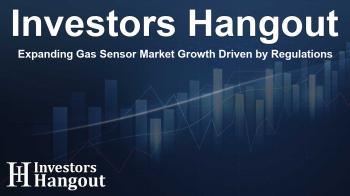Expanding Gas Sensor Market Growth Driven by Regulations

Exploring the Gas Sensor Market: Current Trends and Future Growth
The global gas sensor market is on the cusp of substantial growth, with forecasts indicating a remarkable expansion in the coming years. This progress is largely driven by an increasing demand for environmental monitoring and the necessity of compliance with stringent government regulations.
Market Overview and Growth Projections
The gas sensor market was valued significantly in recent years and is projected to see a considerable rise by the year 2031. Analysts predict a compound annual growth rate (CAGR) of 7.8% during the period leading to 2031.
Technological Innovations and Advancements
With advancements in sensor technology, including wireless communication, intelligent monitoring systems, and artificial intelligence, smart gas sensors are evolving to provide comprehensive and real-time monitoring capabilities. These innovations not only enhance the functionality of gas sensors but also offer early warning features critical for safety.
Addressing Environmental Concerns with Increased Monitoring
Air pollution poses a severe threat to global health, contributing to millions of deaths annually. Awareness of these issues is on the rise, leading to higher demand for effective environmental monitoring solutions. Gas sensors play an essential role, as they are pivotal in detecting harmful gases in the atmosphere, facilitating timely responses to reduce the risks associated with air pollution.
Government Regulations and Compliance Needs
Governments across various regions are implementing stricter regulations regarding air quality and emissions control. This regulatory landscape is a critical driver for the adoption of gas sensors in sectors such as automotive and industrial. Companies are increasingly required to integrate advanced gas sensors into their systems to meet safety standards and limit pollution.
Geographical Insights into Market Dynamics
Analysis shows that Asia Pacific is leading the gas sensor market, holding a substantial portion of the market share. This region's dominance is expected to persist through the forecast period, provided ongoing industrialization and urbanization continue to necessitate advanced monitoring solutions.
Market Segmentation and Key Applications
The gas sensor market can be segmented based on product type, technology, and end-use application. Different types of gas sensors—including carbon dioxide and carbon monoxide sensors—are utilized across diverse industries, from medical facilities to industrial sectors, reflecting their versatility and importance.
Key Players Shaping the Competitive Landscape
The competitive landscape is characterized by the presence of several notable players in the gas sensor market. Companies such as Alphasense, Honeywell Analytics, and MSA are at the forefront, adopting strategies like product innovation and geographic expansion to retain a competitive edge.
Recent Developments and Innovations in Gas Sensing Technology
Recent launches in the gas sensor market are paving the way for enhanced measurement capabilities. For instance, advancements in portable gas detection tools have significantly improved the versatility and accuracy of monitoring hazardous environments, demonstrating the industry's shift towards smarter and safer options.
Conclusion and Future Outlook
The gas sensor market is experiencing a transformative phase, driven by technological advancements, increased regulatory scrutiny, and an urgent need for environmental safety in various sectors. As the world transitions towards a more environmentally conscious era, the demand for effective gas sensors will undoubtedly grow. Stakeholders, ranging from manufacturers to end-users, will find valuable insights within this evolving landscape to harness new opportunities effectively.
Frequently Asked Questions
What is the expected growth rate of the gas sensor market?
The gas sensor market is projected to grow at a CAGR of 7.8% from 2024 to 2031.
What drives the growth of the gas sensor market?
The growth is primarily driven by the rising need for environmental monitoring and stringent government regulations regarding air quality and emissions.
Which regions dominate the gas sensor market?
Asia Pacific is currently the leading region in the gas sensor market and is expected to maintain its dominance during the forecast period.
What types of gas sensors are available in the market?
The market features various types of gas sensors, including carbon dioxide sensors, carbon monoxide sensors, and oxygen sensors, each serving different applications.
Who are the major players in the gas sensor market?
Key players include companies like Alphasense, Honeywell Analytics, and MSA, which are focusing on innovation and expanding their market reach.
About Investors Hangout
Investors Hangout is a leading online stock forum for financial discussion and learning, offering a wide range of free tools and resources. It draws in traders of all levels, who exchange market knowledge, investigate trading tactics, and keep an eye on industry developments in real time. Featuring financial articles, stock message boards, quotes, charts, company profiles, and live news updates. Through cooperative learning and a wealth of informational resources, it helps users from novices creating their first portfolios to experts honing their techniques. Join Investors Hangout today: https://investorshangout.com/
Disclaimer: The content of this article is solely for general informational purposes only; it does not represent legal, financial, or investment advice. Investors Hangout does not offer financial advice; the author is not a licensed financial advisor. Consult a qualified advisor before making any financial or investment decisions based on this article. The author's interpretation of publicly available data presented here; as a result, they should not be taken as advice to purchase, sell, or hold any securities mentioned or any other investments. If any of the material offered here is inaccurate, please contact us for corrections.
